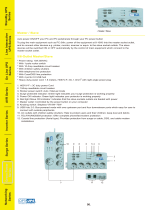
3.6.4 DLC16 Card (KX-TDA0172) .........................................................................................104
3.6.5 SLC8 Card (KX-TDA0173) ...........................................................................................106
3.6.6 EXT-CID Card (KX-TDA0168) ......................................................................................108
3.6.7 SLC16 Card (KX-TDA0174), MSLC16 Card (KX-TDA0175), and CSLC16 Card
(KX-TDA0177) ..............................................................................................................109
3.6.8 MCSLC16 Card (KX-TDA1176) and MCSLC24 Card (KX-TDA1178) .........................111
3.6.9 IP-EXT16 Card (KX-TDA0470) ....................................................................................114
3.7 Information about the Other Physical Cards ..............................................................116
3.7.1 OPB3 Card (KX-TDA0190) ..........................................................................................116
3.7.2 DPH4 Card (KX-TDA0161) ..........................................................................................117
3.7.3 EIO4 Card (KX-TDA0164) ............................................................................................119
3.7.4 ECHO16 Card (KX-TDA0166) ......................................................................................122
3.7.5 MSG4 Card (KX-TDA0191) ..........................................................................................123
3.7.6 ESVM4 Card (KX-TDA0194) ........................................................................................124
3.8 Connection of Extensions ............................................................................................125
3.8.1 Maximum Cabling Distances of the Extension Wiring (Twisted Cable) ........................125
3.8.2 Parallel Connection of the Extensions ..........................................................................127
3.8.3 Digital EXtra Device Port (Digital XDP) Connection .....................................................130
3.8.4 First Party Call Control CTI Connection .......................................................................134
3.9 Connection of Doorphones, Door Openers, External Sensors, and External
Relays .............................................................................................................................135
3.9.1 Connection of Doorphones, Door Openers, External Sensors, and External
Relays ..........................................................................................................................135
3.10 Connection of Peripherals ...........................................................................................138
3.10.1 Connection of Peripherals ............................................................................................138
3.11 LAN Connection ............................................................................................................142
3.11.1 LAN Connection ...........................................................................................................142
3.12 Power Failure Connections ..........................................................................................143
3.12.1 Power Failure Connections ..........................................................................................143
3.13 Starting the PBX ............................................................................................................145
3.13.1 Starting the PBX ...........................................................................................................145
4 Guide for the Maintenance Console ...................................................147
4.1 Overview ........................................................................................................................148
4.1.1 Overview ......................................................................................................................148
4.2 PC Connection ..............................................................................................................149
4.2.1 PC Connection .............................................................................................................149
4.3 Installation of the Maintenance Console ....................................................................152
4.3.1 Installing and Starting the Maintenance Console .........................................................152
5 Troubleshooting ...................................................................................155
5.1 Troubleshooting ............................................................................................................156
5.1.1 Installation ....................................................................................................................156
5.1.2 Connection ...................................................................................................................159
5.1.3 Operation ......................................................................................................................161
5.1.4 Using the Reset Button ................................................................................................163
5.1.5 Troubleshooting by Error Log .......................................................................................164
6 Appendix ...............................................................................................167
6.1 Revision History ............................................................................................................168
6.1.1 PMMPR Software File Version 2.0xxx .........................................................................168
6.1.2 PMMPR Software File Version 2.01xx .........................................................................169
6.1.3 PMMPR Software File Version 3.0xxx .........................................................................170
6.1.4 PMMPR Software File Version 4.1xxx .........................................................................171
6.1.5 PMMPR Software File Version 5.0xxx .........................................................................172
18 Installation Manual Document Version 2011-10
Table of Contents




















